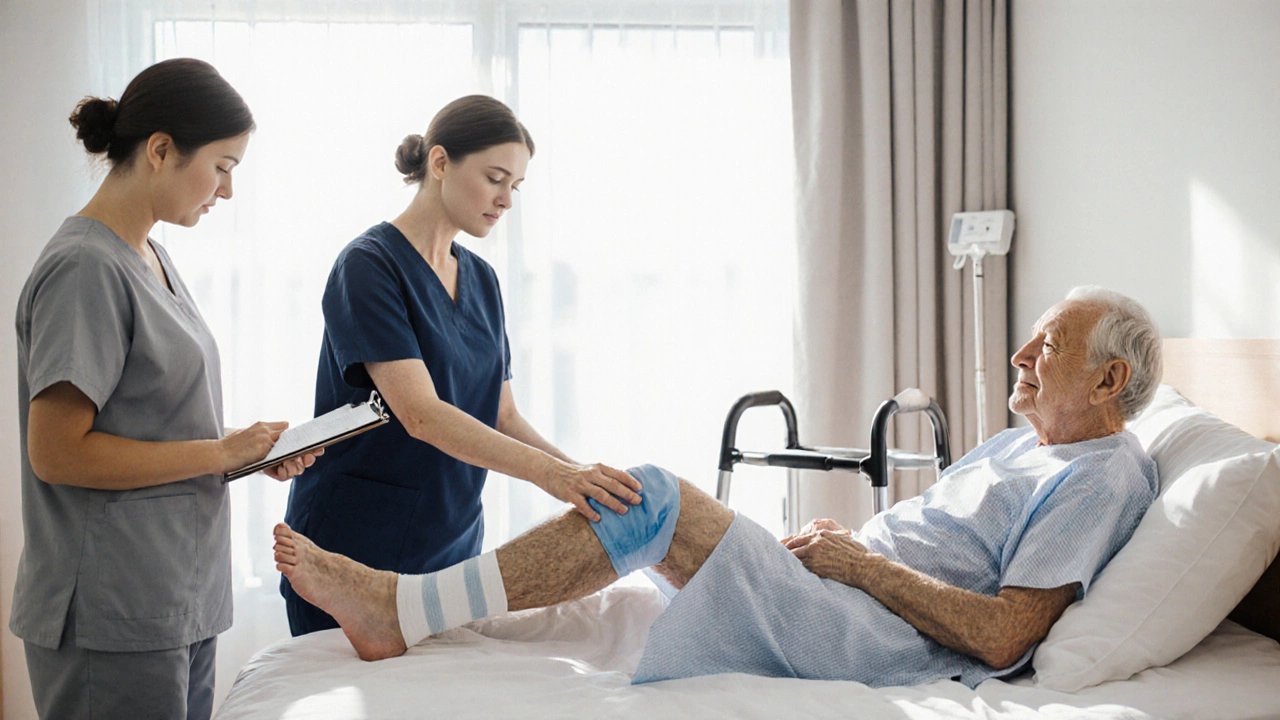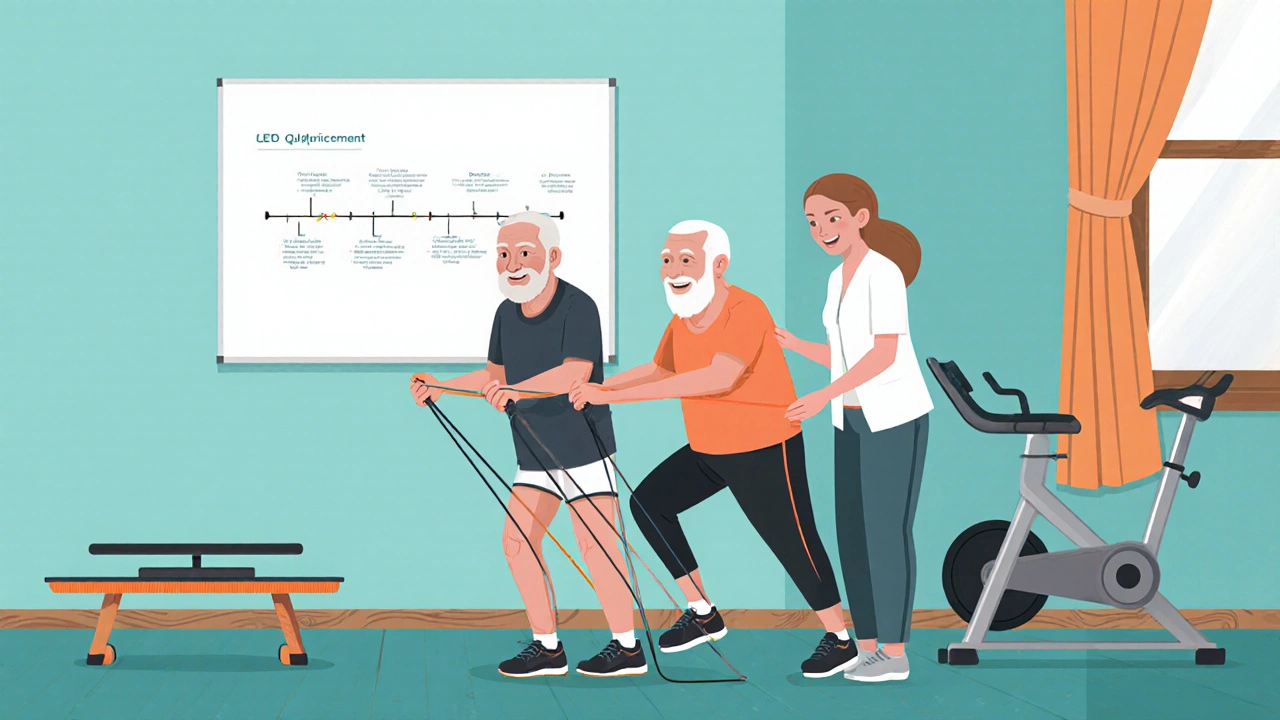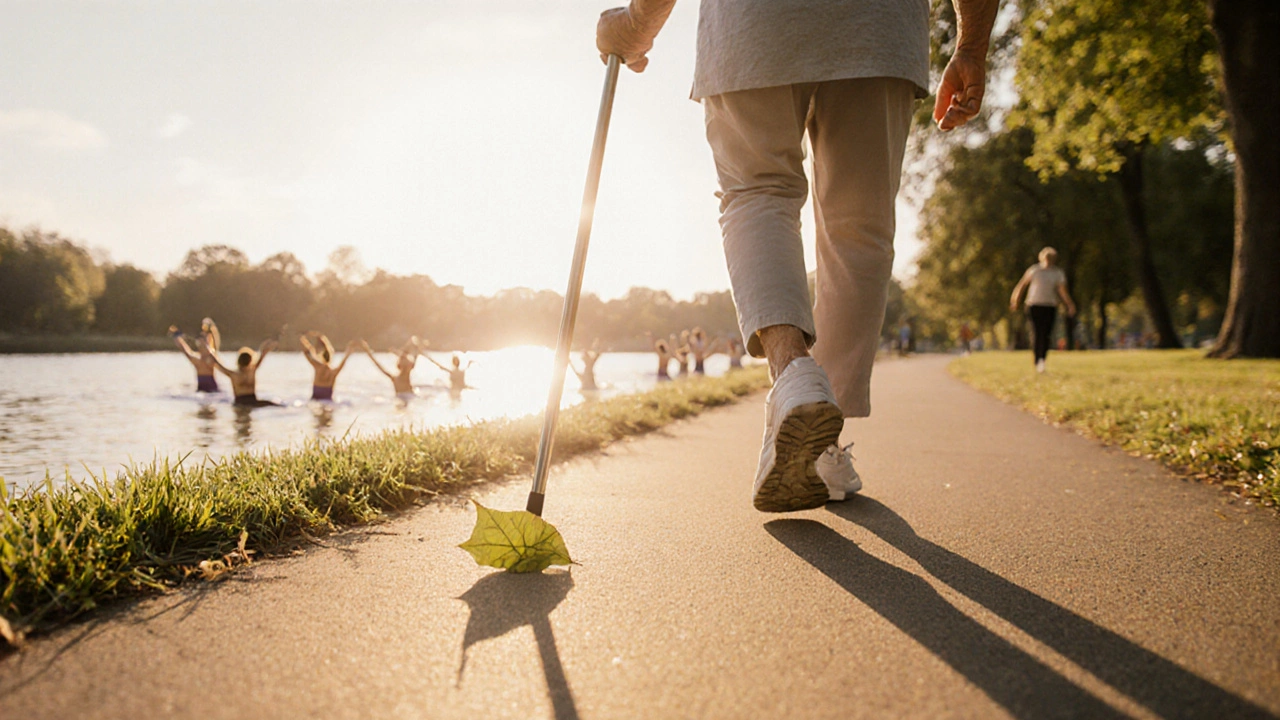
Knee Surgery Recovery Time Estimator
Get an estimated recovery timeline based on your health status, fitness level, and rehabilitation adherence.
Key Takeaways
- Most 70‑year‑olds need 3‑6 months to regain basic mobility after a knee replacement.
- Individual pace varies with health status, pre‑surgery fitness, and rehab adherence.
- Early physical therapy, proper pain control, and nutrition are the biggest boosters.
- Watch for warning signs such as persistent swelling, fever, or sudden loss of movement.
- Full return to high‑impact sports may take a year or more.
When a 70‑year‑old faces knee surgery, the biggest question is usually how long the road to feeling like yourself will take. The answer isn’t a single number; it’s a range shaped by a mix of biology, medical care, and daily habits. Below we break down everything you need to know to set realistic expectations and plan a smoother recovery.
Knee surgery is a broad term that covers procedures ranging from arthroscopy to total knee replacement. In the United Kingdom, the most common operation for severe osteoarthritis in seniors is a Total Knee Replacement (also called arthroplasty). This surgery swaps out the worn cartilage and bone with metal and plastic components, aiming to restore pain‑free movement.
Understanding Recovery Time for Seniors
Recovery time, or the period needed to move from a post‑operative hospital bed to walking unaided, depends heavily on age‑related factors. While a healthy 30‑year‑old might walk without crutches in a week, a 70‑year‑old typically follows a slower, more structured timeline. The Recovery time refers to the overall duration required to achieve functional independence after knee surgery, including pain control, joint range of motion, and muscle strength. can be divided into distinct phases:
- Hospital stay (Day 0‑3): Most patients are discharged after 2‑4 days unless complications arise.
- Early recovery (Week 1‑2): Focus on swelling control, gentle range‑of‑motion exercises, and short walks with a walker.
- Intermediate phase (Weeks 3‑8): Increase strength training, transition to a cane, and work on balance.
- Advanced rehab (Months 3‑6): Aim for full weight‑bearing, climb stairs confidently, and resume low‑impact activities.
- Peak functional outcome (Months 9‑12): Many seniors report reaching their best subjective knee score around this time.
Typical Milestones - A Week‑by‑Week Snapshot
Below is a concise reference that maps common goals to weeks after surgery. Individual progress may vary, but the chart helps you see whether you’re on track.
| Week | Typical Goal | Key Activities | Expected Outcome |
|---|---|---|---|
| 1‑2 | Manage pain & swelling | Cold therapy, ankle pumps, assisted walking | Walk 10‑15m with walker; Range of motion 30‑90° flexion |
| 3‑4 | Increase strength | Quadriceps sets, straight‑leg raises, stationary bike | Stand from a chair without assistance; flexion 90‑110° |
| 5‑8 | Transition to cane | Step‑up exercises, balance board, gait training | Walk 50‑100m with cane; climb one flight of stairs |
| 9‑12 | Full weight‑bearing | Resistance bands, low‑impact aerobics, swimming | Walk 300‑500m without aid; normal daily chores |
| 13‑24 | Return to low‑impact sports | Cycling, golf, water aerobics | Comfortable participation in recreational activity 2‑3 times per week |

Factors That Influence How Fast You Heal
Not every 70‑year‑old moves at the same speed. The following variables can either accelerate or slow the process:
- Pre‑existing health conditions: Diabetes, heart disease, or chronic lung problems can hamper circulation and tissue repair.
- Body mass index (BMI): Higher BMI adds stress to the new joint, often extending the timeline.
- Muscle strength before surgery: A strong quad muscle can reduce the need for prolonged therapy.
- Smoking status: Nicotine constricts blood vessels, delaying wound healing.
- Nutrition: Adequate protein (1.2‑1.5g/kg body weight) and vitaminC support collagen formation.
Understanding these Comorbidities are additional health issues that coexist with the primary condition and can affect surgical outcomes. helps you and your surgeon set realistic goals and possibly adjust the rehab plan.
Physical Therapy - The Engine of Recovery
Physical therapy is the cornerstone of regaining function. A qualified Physical therapist is a licensed health professional specialized in restoring movement, strength, and balance after injury or surgery. will guide you through a Rehabilitation protocol a structured series of exercises and milestones designed to optimize joint performance after surgery.. Typical sessions (3‑5 times per week for the first 8 weeks) include:
- Passive and active range‑of‑motion drills.
- Isometric quadriceps contractions to prevent atrophy.
- Closed‑chain strengthening like mini‑squats within pain‑free limits.
- Balance training using a wobble board or single‑leg stance.
- Gait training with a walker, then a cane, focusing on proper step length.
Adhering to the protocol reduces the chance of stiffness, which is a common setback for seniors.
Managing Pain and Avoiding Complications
Pain control is not just about comfort; it enables participation in rehab. Most surgeons prescribe a combination of oral analgesics, a short course of NSAIDs, and occasionally a low‑dose opioid for the first few days. Local infiltration analgesia (LIA) - a mix of anesthetic and steroid injected around the joint - can cut opioid use by up to 30%.
The most concerning Complications are undesirable events such as infection, blood clots, or prosthetic failure that can delay or jeopardize recovery. to watch for include:
- Increasing redness, warmth, or drainage from the incision - possible infection.
- Unexplained fever over 38°C (100.4°F).
- Sudden calf pain or swelling - signs of deep vein thrombosis (DVT).
- Persistent inability to flex the knee beyond 30° after the first two weeks.
If any of these appear, contact your orthopedic team immediately. Early intervention often prevents a prolonged stay.

Mobility Aids - Choosing the Right Tool
During the early phases, a Walker is a four‑leg frame that provides maximal stability for patients with limited balance. is usually recommended. By week 4‑6, most seniors can safely shift to a single‑point cane. The key is to select a height‑adjusted aid so that the elbow is slightly bent (about 20‑30°) when holding the handle.
When Can You Resume Everyday Activities?
Below is a practical list matching activities to typical recovery windows. Adjust according to personal comfort and doctor’s advice.
- Driving: Usually safe after 4‑6 weeks if you can comfortably press the pedals without pain.
- Household chores: Light tasks (dusting, washing dishes) can begin in week 2‑3; heavier tasks (vacuuming, lifting objects >10kg) wait until month 3.
- Walking long distances: Gradually increase distance; aim for 30‑45minutes without aid by month 4.
- Travel: Short flights (under 2hours) are fine after 6 weeks; longer trips should be planned post‑3months.
- Recreational sports: Low‑impact options (swimming, cycling) from month 3; high‑impact (tennis, jogging) often delayed until 9‑12 months.
Remember, the goal isn’t to race to 100%, but to build a sustainable level of function that matches your lifestyle.
Quick Checklist for a Smooth Recovery
- Attend all scheduled physiotherapy sessions.
- Keep the incision clean and dry; change dressings as instructed.
- Apply ice for 15‑20minutes, 3‑4 times daily during the first two weeks.
- Take prescribed meds on schedule, not just when you feel pain.
- Stay hydrated and eat protein‑rich meals.
- Perform daily at‑home exercises (quad sets, heel slides).
- Monitor for red flags (fever, swelling, severe pain).
Following this plan maximizes the odds of a recovery that feels steady rather than erratic.
Frequently Asked Questions
How long will I need a walker after knee replacement?
Most seniors transition from a walker to a cane between weeks 4 and 6, provided they have good balance and can achieve at least 90° of knee flexion. Your therapist will test these milestones before clearing you.
Can I take NSAIDs if I have a history of ulcers?
If ulcers are a concern, discuss alternatives with your surgeon. A short course of COX‑2 selective inhibitors or acetaminophen may be safer, and gastro‑protective medication can be added if NSAIDs are unavoidable.
Is it normal to feel a grinding sensation in the new knee?
A mild clicking or popping is common during the first few months as scar tissue forms. Persistent grinding, especially with pain, should be evaluated for component malalignment or wear.
When can I safely lift heavy objects?
Limit lifting to under 5kg for the first 8 weeks. Gradually increase to 10‑15kg after 3 months, and avoid lifting overhead until you have regained full quadriceps strength (often around 6 months).
What diet helps speed up knee surgery recovery?
Aim for a balanced diet rich in lean protein (chicken, fish, legumes), omega‑3 fatty acids, and antioxidants (berries, leafy greens). VitaminD and calcium support bone health, while adequate fluid intake keeps joints lubricated.





Rohan Talvani
I am a manufacturing expert with over 15 years of experience in streamlining production processes and enhancing operational efficiency. My work often takes me into the technical nitty-gritty of production, but I have a keen interest in writing about medicine in India—an intersection of tradition and modern practices that captivates me. I strive to incorporate innovative approaches in everything I do, whether in my professional role or as an author. My passion for writing about health topics stems from a strong belief in knowledge sharing and its potential to bring about positive changes.
view all postsWrite a comment